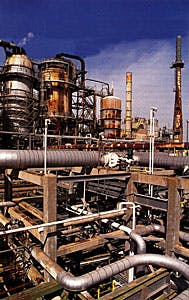The BP-Amoco refinery in Texas City, Tex., has used a neural-networks system in its atmospheric distillation unit since 1996.By applying a new advanced-control system to its crude-tower process, Amoco Oil Petroleum Products Co. (now BP-Amoco) Texas City refinery saved more than $500,000/year in recovered product, according to the company.
The Texas City refinery's atmospheric crude unit takes preheated crude oil and separates it into five streams: top stream (to vapor recovery), naphtha, kerosine, diesel (the primary product), and bottom stream.
The distillation unit has a capacity of more than 400,000 b/d of crude.
New software
The company's on-stream analyzers are subject to time delays of more than 30 min. Thus, BP-Amoco looked for a way to reduce its reaction time to stream data.Since 1996, the refinery has used Gensym's G2 Diagnostic Assistant (GDA) software and three neural net models created with Gensym's Neur- On-Line to help control distillation. The GDA software and the neural net models allow BP-Amoco to provide continuous, real-time control over its crude-fractionation process.
Neural network models are developed to infer process stream data when analyzers are not reliable or are too expensive.
The advanced control system, the GDA, allows BP-Amoco to be proactive in its process control. NeurOn-Line models provide instantaneous estimates of quality values, which are expressed as boiling point temperatures for 90% cuts. These values are then used in a closed-loop control.
The advanced control application was first used to optimize diesel cuts, automatically adjusting diesel and kerosine flow. It was then extended to include naphtha production.
The three NeurOn-Line models of naphtha, kerosine, and diesel production use between 44 and 46 inputs each. BP-Amoco has run duplicate nets totaling 268 input nodes with no noticeable computer loading.
Results
With these systems, BP-Amoco created a control system featuring "soft sensor" values for these compositions. With the G2 software used for closed-loop control, more than 95% closed-loop utilization resulted. In addition, BP-Amoco estimates a savings of more than $500,000/year in recovered product."NeurOn-Line's ability to deliver quality values in real time makes it possible to run this advanced control much more tightly," says David Middleton, the BP-Amoco computer specialist who implemented the project. "By learning of the outcome early, we are able to maintain final boiling point specifications of the product streams within tighter limits. It also keeps the product from drifting off spec."
BP-Amoco is considering the use of NeurOn-Line to maintain product quality specs at several other production facilities.
Copyright 1999 Oil & Gas Journal. All Rights Reserved.


